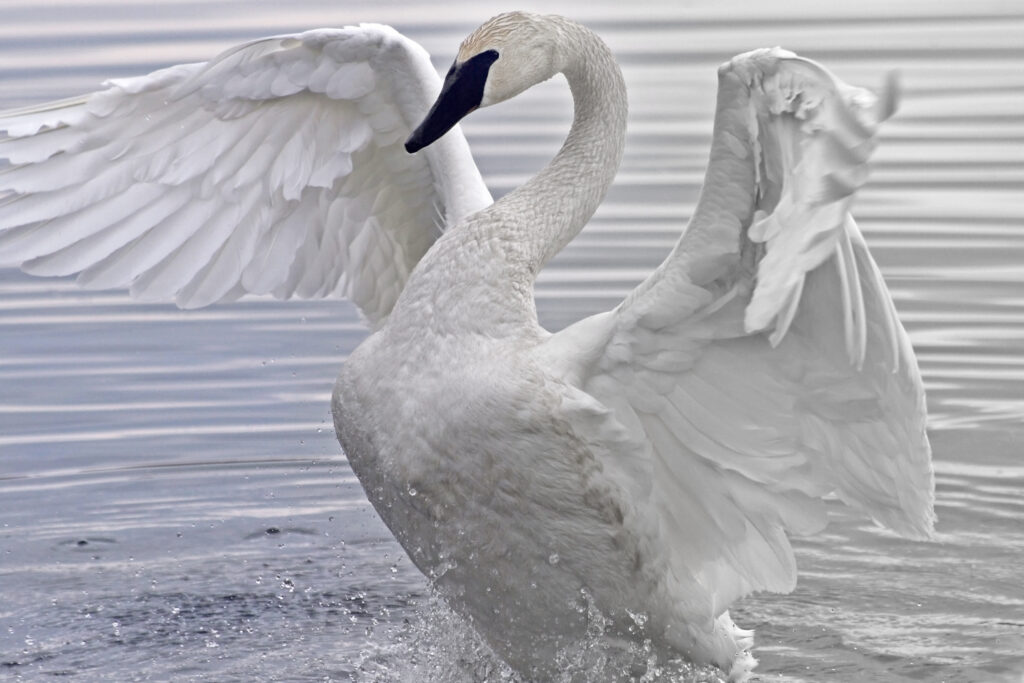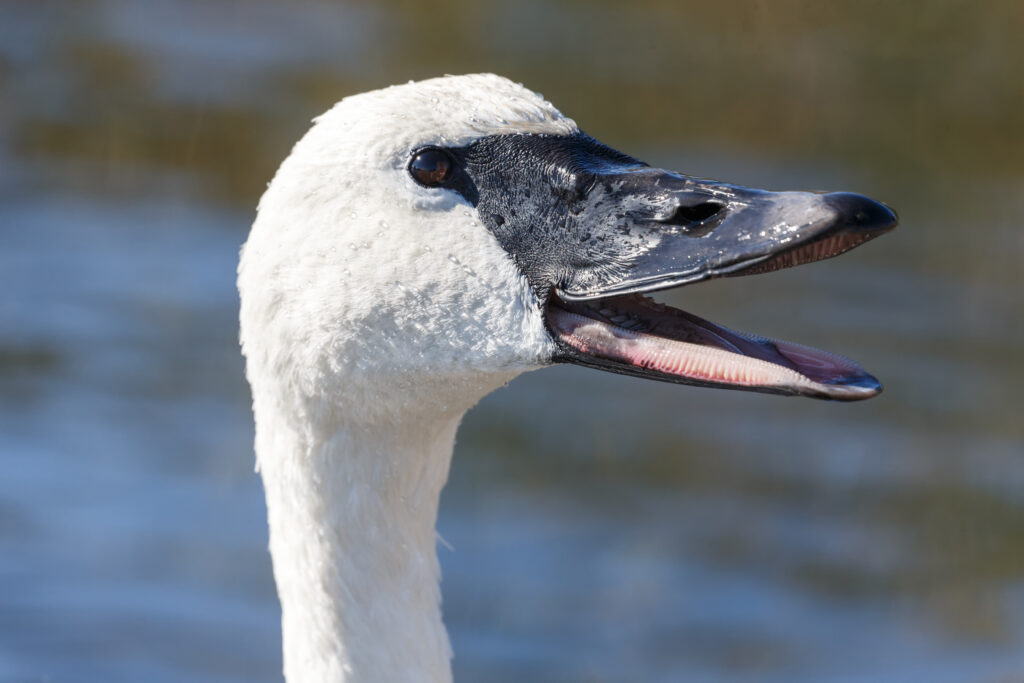
Three new swans are in care at the wildlife centre right now. All are victims of fishhooks.
Two are brothers, but they don’t seem to like each other much. Staff tried to place them in the same room together, and it didn’t go well. They are adult males and that rivalry overrides any family bonds. Two of the three birds are from Tommy Thompson Park, so I assume those are the brothers. They now each have their own large pool in their own care room.
In addition to Tommy Thompson Park, are also swans in High Park, Bluffer’s Park in Scarborough, LaSalle Park in Burlington, and other urban locations, but I don’t know where the third bird in care came from.
The New York Times reported in spring of last year: “Restoration efforts in Ontario, Canada, have helped a once-vanquished population to flourish. And they have been sighted in new habitats in the United States, too.”
“Winter is a social time for swans and as a result we often see as many as 100 swans coming from further north to enjoy their ‘social afternoon,’ says a Toronto Region Conservation Society article about the Trumpeter Swans in Bluffers Park.
This is the time of year when the Trumpeter Swan Restoration Program will tag and band as many untagged swans as possible “so that the Trumpeter Swan Restoration Program can follow their progress, breeding patterns and degree of success in relearning their migratory routes. Tagging the swans lets us not only track their movements, but also to understand their behaviour.”
“Bluffers Park has been home to a breeding pair for over 25 years. The previous male, Charley or Whitey as he was known, was a huge favourite in the boating community and he was here for almost 20 years. Unfortunately, he had to be put to sleep after a deadly encounter with discarded fishing tackle.”
Every year, Toronto Wildlife Centre admits animals that have been affected or injured by discarded fishing equipment. “Hooks can get embedded and cause infection and injury, lines get tangled around feet and wings and impede mobility or cause constriction issues, and sinkers when swallowed can cause deadly lead poisoning,” says the TWC.
The swans, ducks, and other aquatic birds affected often need x-rays and surgery to remove the metal paraphernalia and repair the internal damage. Then lots of care to heal before being ready to return to the wild.
And I gotta say, from what I have seen so far, swans are not easy patients! They can be spazzy and pool-jumpers. (Getting out of their care pool can be dangerous for the swans, as they can get injured.) They are often stressed out, aggressive, feisty, and want to get back to their home and mate.
Shockingly, I just read that, despite being native to North America, thirty years ago there were no trumpeters left in Ontario. What??!!?
Margaret Bream wrote in a Toronto Star article that, “Trumpeter swans …were once found on a large swath of the continent. But the huge birds, the largest waterfowl extant in the world, were hunted to the brink of extinction in the last century, with only a few small colonies remaining out West. The birds were prized as food, their extremely long white feathers and their leather. … But Lumsden [Harry Lumsden, a retired Ministry of Natural Resources biologist and founder of the Ontario Trumpeter Swan Restoration Program] obtained a few wild birds and eggs from the Western colonies, brought them back to Ontario and raised them as coddled captives. When the birds were a few years old and ready to fend for themselves, they were released back into the wild in this province.”
Harry Lumsden, who founded the Ontario Trumpeter Swan Restoration Program, was honoured with the Order of Canada in 2004. The Governor-General’s news release said, “he has shared his knowledge of aviculture with the general public. He has inspired volunteers to follow his lead in breeding Canada geese and trumpeter swans, successfully reintroducing these birds to Ontario. Known for his passion and dedication, he continues to stimulate public interest in wildlife conservation.”
The Trumpeter Swan Society website says: Trumpeter Swans are native only to North America. They are the largest waterfowl in the world. Although most populations are increasing, they are one of our least abundant native birds with about 63,000 Trumpeters on the entire continent.
The Society website also says that swan parents teach their young migration routes, wintering sites, and how to survive in the wild. Sadly, with the near extinction of Trumpeter Swans, came the loss of migration traditions and knowledge of local landscapes. Swan restoration programs in the 1980s was with eggs from Alaska. The swans hatched from those eggs had no knowledge of their new landscape. As swans began to slowly return to the landscape, they had to pioneer and learn new migration traditions, find secure wintering sites, and discover nesting habitat in areas where they had been gone for more than a century.
There is a “Trumpeter Watch” where anyone can report a Trumpeter Swan sighting. This helps swan managers across North America to track where the swans are spending their winters and summers, and the migration time in between. You can report a swan sighting here.
Turtles, birds, fish, and raptors like hawks and owls who hunt near water, are all frequent victims of fishing tackle garbage. If you see an animal who is tangled in fishing line, or if you know a wild animal has swallowed a hook, contact a permitted wildlife rehabilitator for advice. If you are in the greater Toronto area, you can call the Toronto Wildlife Centre Hotline at 416-631-6002 and there is an assistance request form online here.
“To form a perfect conception of the beauty and elegance of these Swans, you must observe them when they are not aware of your proximity, and as they glide over the waters of some secluded inland pond. On such occasions, the neck, which at other times is held stiffly upright, moves in graceful curves, now bent forward, now inclined backwards over the body. Now with an extended scooping movement the head becomes immersed for a moment, and with a sudden effort a flood of water is thrown over the back and wings, when it is seen rolling off in sparkling globules, like so many large pearls. The bird then shakes its wings, beats the water, and as if giddy with delight shoots away, gliding over and beneath the surface of the liquid element with surprising agility and grace. Imagine, reader, that a flock of fifty Swans are thus sporting before you, as they have more than once been in my sight, and you will feel, as I have felt, more happy and void of care than I can describe.” — John James Audubon (1843)

A few resources:
Toronto Wildlife Centre is Canada’s largest and busiest wildlife centre, and the GTA’s only wildlife hospital: www.torontowildlifecentre.com
The Trumpeter Swan Coalition is committed to ensuring LaSalle Park Harbour, the winter home of 1/4 of Ontario’s Trumpeter Swans, is protected: www.trumpeterswancoalition.com
The Trumpeter Swan Society has been North America’s leader of Trumpeter Swan conservation with a mission to assure the vitality and welfare of wild Trumpeter Swans: www.trumpeterswansociety.org
